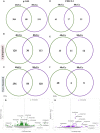Simulated galactic cosmic ray exposure activates dose-dependent DNA repair response and down regulates glucosinolate pathways in arabidopsis seedlings
- PMID: 38162303
- PMCID: PMC10757676
- DOI: 10.3389/fpls.2023.1284529
Simulated galactic cosmic ray exposure activates dose-dependent DNA repair response and down regulates glucosinolate pathways in arabidopsis seedlings
Abstract
Outside the protection of Earth's magnetic field, organisms are constantly exposed to space radiation consisting of energetic protons and other heavier charged particles. With the goal of crewed Mars exploration, the production of fresh food during long duration space missions is critical for meeting astronauts' nutritional and psychological needs. However, the biological effects of space radiation on plants have not been sufficiently investigated and characterized. To that end, 10-day-old Arabidopsis seedlings were exposed to simulated Galactic Cosmic Rays (GCR) and assessed for transcriptomic changes. The simulated GCR irradiation was carried out in the NASA Space Radiation Laboratory (NSRL) at Brookhaven National Lab (BNL). The exposures were conducted acutely for two dose points at 40 cGy or 80 cGy, with sequential delivery of proton, helium, oxygen, silicon, and iron ions. Control and irradiated seedlings were then harvested and preserved in RNAlater at 3 hrs post irradiation. Total RNA was isolated for transcriptomic analyses using RNAseq. The data revealed that the transcriptomic responses were dose-dependent, with significant upregulation of DNA repair pathways and downregulation of glucosinolate biosynthetic pathways. Glucosinolates are important for plant pathogen defense and for the taste of a plant, which are both relevant to growing plants for spaceflight. These findings fill in knowledge gaps of how plants respond to radiation in beyond-Earth environments.
Keywords: Arabidopsis; DNA damage response; galactic cosmic ray; glucosinolate pathway; space radiation; transcriptomic analysis.
Copyright © 2023 Dixit, Meyers, Richardson, Richards, Richards, Neelam, Levine, Cameron and Zhang.
Conflict of interest statement
AD and JR were employed by the company AETOS Systems Inc. under NASA LASSO II contract. SR was employed by the company Bionetics Corp. under NASA LASSO contract. The remaining authors declare that the research was conducted in the absence of any commercial or financial relationships that could be construed as a potential conflict of interest. The funders had no role in the design of the study; in the collection, analyses, or interpretation of data; in the writing of the manuscript, or in the decision to publish the results.
Figures






Similar articles
-
Response of Arabidopsis thaliana and Mizuna Mustard Seeds to Simulated Space Radiation Exposures.Life (Basel). 2022 Jan 19;12(2):144. doi: 10.3390/life12020144. Life (Basel). 2022. PMID: 35207432 Free PMC article.
-
NASA's first ground-based Galactic Cosmic Ray Simulator: Enabling a new era in space radiobiology research.PLoS Biol. 2020 May 19;18(5):e3000669. doi: 10.1371/journal.pbio.3000669. eCollection 2020 May. PLoS Biol. 2020. PMID: 32428004 Free PMC article.
-
Life-long brain compensatory responses to galactic cosmic radiation exposure.Sci Rep. 2021 Feb 22;11(1):4292. doi: 10.1038/s41598-021-83447-y. Sci Rep. 2021. PMID: 33619310 Free PMC article.
-
Galactic cosmic ray simulation at the NASA space radiation laboratory - Progress, challenges and recommendations on mixed-field effects.Life Sci Space Res (Amst). 2023 Feb;36:90-104. doi: 10.1016/j.lssr.2022.09.001. Epub 2022 Sep 10. Life Sci Space Res (Amst). 2023. PMID: 36682835 Review.
-
Getting ready for the manned mission to Mars: the astronauts' risk from space radiation.Naturwissenschaften. 2007 Jul;94(7):517-26. doi: 10.1007/s00114-006-0204-0. Epub 2007 Jan 19. Naturwissenschaften. 2007. PMID: 17235598 Review.
Cited by
-
Simulated deep space exposure on seeds utilizing the MISSE flight facility.NPJ Microgravity. 2025 Jan 17;11(1):3. doi: 10.1038/s41526-024-00451-y. NPJ Microgravity. 2025. PMID: 39824863 Free PMC article.
-
Translational insights into abiotic interactions: From Arabidopsis to crop plants.Plant Cell. 2025 Jul 1;37(7):koaf140. doi: 10.1093/plcell/koaf140. Plant Cell. 2025. PMID: 40579370 Free PMC article. Review.
References
-
- Aguilar-Quesada R., Muñoz-Gámez J. A., Martín-Oliva D., Peralta A., Valenzuela M. T., Matínez-Romero R., et al. . (2007). Interaction between ATM and PARP-1 in response to DNA damage and sensitization of ATM deficient cells through PARP inhibition. BMC Mol. Biol. 8, 29. doi: 10.1186/1471-2199-8-29 - DOI - PMC - PubMed
-
- Arena C., De Micco V., Macaeva E., Quintens R. (2014. b). Space radiation effects on plant and mammalian cells. Acta Astronaut. 104, 419–431. doi: 10.1016/j.actaastro.2014.05.005 - DOI
LinkOut - more resources
Full Text Sources
Miscellaneous

